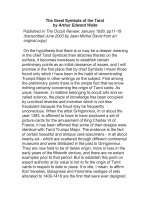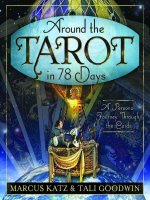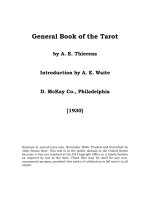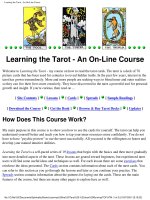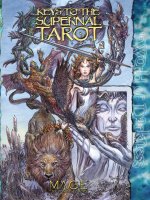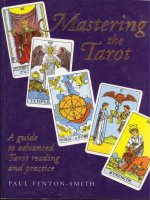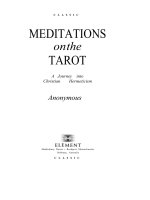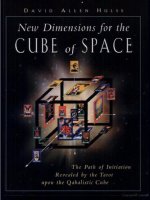Hướng dẫn bói bài Tarot Tarot and the magus opening the key to divination, magick and the holy guardian angel
Bạn đang xem bản rút gọn của tài liệu. Xem và tải ngay bản đầy đủ của tài liệu tại đây (4.52 MB, 205 trang )
THETAROT AND THE MAGUS
OPENING THE KEY TO DIVINATION, MAGICK
AND THE HOLY GUARDIAN ANGEL
Paul Hughes-Barlow is a practicing Magician and Tarot Reader.
He regularly speaks at conferences and events, and has consulted to
many journals and websites.
He currently resides and practices in Brighton, England
A E O N
THE TAROT A N D THE MAGUS
OPENING THE KEY TO DIVINATION, MAGICK
AND THE HOLY GUARDIAN ANGEL
Paul Hughes-Barlow
A E O N
First published 2004
by Aeon Books Limited
London NW3
www.aeonbooks.co.uk
0Paul Hughes-Barlow 2004
The moral right of the author has been asserted
AU rights reserved. No part of
this book may be
reproduced or utilized in any form or by any means,
electronic or mechanical, without permission in writing
from the publisher.
British Library Cataloguing in Publication Data
A C.I.P. is available for this book from the British Library
llustrations from Aleister Crowley Thoth Tarot@reproduced
by permission of AGM AGMiiller. OAGM AGMiiller / OTO.
Extracts from the works of Aleister Crowley by permission of the OTO.
ISBN 1 904658 02 4
Printed and bound in Great Britain by MPG Biddles
To Punditt Maharaj
Acknowledgements
Gerard Encausse, Gliphas Lkvi, McGregor Mathers and Aleister
Crowley, whose writings hint at many mysteries.
On the internet Jess Karlin and George Leake showed me the value of
rigorous scholarship on the Tarot, while the email queries from tarot
students around the world inspired me to create and develop the
Tarot Lessons on Supertarot, the basis of this book.
My best inspiration comes from people not obviously associated with
Tarot. Punditt’s mysticism, teachings and spiritual help have always
been forthcoming. Beryl’s spiritual and inspirational help and faith in
my abilities continues down the years, especially during the many
dark days. Elayne gave me space and more to write in Houston Texas;
the timely trip to New Orleans transformed the magical and spiritual
direction of this book. Prosper0 provided mutual encouragement on
writing books on Tarot in the various pubs of Kemptown. Last but not
least, my Publisher who courageously allowed me to develop the
book in ways beyond the original remits.
CONTENTS
INTRODUCTION
1
CHAPTER ONE
The Fool, The Universe and the Aces
The Opening of the Key Spread
7
CHAPTER TWO
The Magus, The Aeon, the Twos and the Kings
Overview of Reading the Cards
15
CHAPTER THREE
The Priestess, The Sun, the Threes and the Queens
Pairing the Cards
29
CHAPTER FOUR
The Empress, The Moon and the Fours
Elemental Dignities
43
CHAPTER FIVE
The Emperor, The Star and the Fives
Card Counting: Golden Dawn Tarot Sutras
63
CHAPTER SIX
The Hierophant, The Tower, the Sixes and the Princes
Unaspected Cards
75
CHAPTER SEVEN
The Lovers, The Devil and the Sevens
Love Relationships
85
CHAPTER EIGHT
The Chariot, Temperance (Art)and the Eights
Performing Readings for the Public
105
CHAPTER NINE
Justice (Adjustment),Death and the Nines
The Visionary Experiences of the Shaman
7 17
CHAPTER TEN
The Hermit, The Hanged Man, the Tens and the Princesses
Sex Magick
137
CHAPTER ELEVEN
Fortune, Strength (Lust)
The Spirits of the Tarot
151
APPENDIX I
Meditations
169
APPENDIX I1
The 22 Mercurial Spirits of Liber 231
178
APPENDIX 111
The Qliphot and the Tarot
182
APPENDIX IV
Self Initiation and the Neophyte Spread
186
BlBLlOGRAPHY
7 94
Introduction
With hindsight it should have been obvious to all but the most shallow and
incompetent magician that a book structured upon the Golden Dawn system of
Tarot and the number eleven would inevitably result in some kind of magical or
spiritual knowledge. However, the fact is that the original ambition was simply
to present the Opening of the Key Spread, based upon the author’s Supertarot
website, to the general public. As the reader will see, this book is no mere primer
on the subject of readng tarot cards.
There are many books on tarot decks in which the format is to present a picture
of each card, provide a description and then to give the divinatory meanings.
The format has changed little since A.E. Wake wrote the accompanying book to
the Rider-Waite tarot nearly one hundred years ago. There are also a few books
focussing on the many varieties of tarot spreads. This book is neither. The original
intention was to study the first stage of the Opening of the Key Spread in which
the cards are cut into four piles. The piles are turned over, the top cards analysed
and then one of the piles is spread out in a horseshoe to be analysed using the
Golden Dawn techniques of Pairing and Counting.
I have used this spread professionally for many, many years and promoted
the spread on the Supertarot website. I not unnaturally considered myself fairly
knowledgeable about this spread and was not expecting any surprises during
the writing process. I could not have been more wrong. Since neither I nor the
publisher wanted to create a book based upon the distinctly uninspiring formats
currently followed, we hit upon the idea of structuring the book around eleven
chapters, eleven being Aleister Crowley’s favourite number of magick and
1
2
THE TAROT AND THE MAGUS
change. The chapters would progressively move from Beginners to Advanced,
with the later chapters devoted to more magical themes. Before the contract was
signed, I asked my spiritual teacher for his blessing for writing this book, which
was readily given, and he told me that ‘Spirits would help me’. The first version,
based upon the Supertarot website, was a failure. It would appear that I was not
getting the spiritual assistance I was expecting. For a month, nothing was written.
I was devoid of inspiration, until out of desperation I decided to base the book on
Strings or sequences of cards, which are the basis of the Opening the Key Spread.
On the face of it, this was more ambitious than the ideas found in Supertarot, but
I found I could write easily and comfortably, and the deadline of three months
looked attainable. The Spirits were helping me! When I was on the right track,
ideas bubbled up from somewhere, and when I strayed, no matter how long I sat
in front of the computer, not a word was written.
The Spirits seemed to be helping my Publisher too. It was his idea that I write a
commentary on the paired Major cards at the beginning of each chapter. Frankly,
I thought the idea preposterous, but since I was not getting anywhere, I gave it a
try. Rather than compare and contrast the designs on the cards, an analysis of the
gematria of the Hebrew letters associated with the cards seemed a good starting
point. My expectations were zero, but remarkably the gematria produced relevant
results that reflected on the character not only of the cards but the court cards and
the Minor cards associated with the chapters, particularly when the divinatory
meaning of three or four of a kind are considered. Nobody has ever come up with
a satisfactory explanation for why the pictorial representations of the tarot are as
they are, so perhaps we are closer to an answer.
Moreover, as I approached writing the pairings for the last few chapters, there
came the dim realisation that I had been writing a gnmoire. Quite what this
grimoire represented, I had no real idea. Normally, grimoires usually provide
various spiritual or magical solutions for problems, but this did not fit into that
category. As a grimoire, it also focussed on the kabbalistic and gematriac values
rather than Tarot per se, so I had nothing to go on. Besides, there was a book
to write. The gematria values also threw light on why the Golden Dawn felt the
need to transpose two of the cards. Without transposition, two identical gematria
values occurred, which is clearly not acceptable. Since the Emperor and Star
cards are naturally paired, Aleister Crowley’s transposition of these cards makes
not the slightest difference, and possibly points to an answer as to why there is still
confusion as to the attributions of these cards.
Eleven is not a natural number as a means of analysis of the Tarot, which is
probably why nobody has bothered before. Of course, individual cards can be
analysed, such as the Fortune card, but it is not a fmitful topic in the bigger scheme
of things. Multiplying 11 by that peculiarly sacred number of 7 comes to 77, one
short. If we consider the Fool card to be zero, which it is, then in reality there are
indeed 77 cards. Looking at the gematria (each hebrew letter is also a number
and thus each hebrew word can be given a numerical value, see chart at the end
of this Chapter) the values for 77 are far more inspiring than for 78. We have
BOH, prayed, the river Gihon (Gen, ii, 13), Overflowing, Towers or Citadels, OZ
meaning strength or a he-goat, and finally MZL, described as the influence from
Kether, more commonly known as luck. It was not until the latter stages of writing
this book that the the structure based upon 7 x 1 1 presented itself in the form of a
new tarot spread that represents the modules or formulae of the structure of the
Golden Dawn rituals. Although it is obvious that the Tarot is at the heart of the
structure of the Golden Dawn rituals and teachings, I have for a long time been
suspicious of the Pathworking relationships there had to be other ways, one of
which is the eleven steps relating to the General Exordium. The author has not
had the time to fully explore the General Exordium in relationship to the Tarot,
except to point out some possible avenues of exploration in to be found in the
Meditations in Appendix I.
The author has always been of the opinion that there are 78 cards in a Tarot
deck, despite several attempts to produce decks of 80 cards. New students of
the Thoth tarot regularly ask why some versions of the decks have three Magus
Cards, to which no satisfactory answer has been found, except to advise the
student to discard two of the three Magi. The writing of this book has forced me
to reconsider many sacred cows, as well as take a fresh look at older ideas. The
fact is that approaching the Tarot from the direction of this book results in an
extraordinary upsurge in creativity. Almost every day I get new ideas that could
well go in another book on the Tarot. The possibilities are truly endless.
There are many innovations in this book. Although all the cards are discussed
in some form, I have tried to take a sideways look at the cards, part of which comes
from the inspiration of the Grimoire. As such, Aleister Crowley’s Book of Thoth has
been the prime source of inspiration, sometimes in relation to the Golden Dawn
version. It has been the author’s contention that the Book of Thoth is far closer to
the precepts of the Golden Dawn than the so-called Golden Dawn Tarot decks,
which contribute nothing to the genre. Crowley made genuine contributions to
the Tarot, many of which have never been properly discussed. For example, why
did he not name the deck the Tarot of Thelema? It was during the writing of
this book that I unexpectedly got answers. I say unexpectedly because I have had
questions like these for years and never gotten any answers.
~
Chapter 1 introduces the practicalities of the Opening of the Key Spread. The
action of shuffling, dealing, counting and pairing is a ritual that helps the reader
and Querent to be in a receptive state for the revelations that might appear.
4
THE TAROT AND THE MAGUS
Chapter 2 looks at the various ways of analysing the cards since the human
brain is wired to see patterns. Since all 78 cards are used in a reading, divided
into four piles, it is possible to look at the full representation of say all the fours,
or the absence of a particular group of cards. One way of understanding this
information is to look at the excess or absence of the sephiroth on the Tree of
Life which gives a graphic representation of the dynamics of the String of cards,
and should suggest magical balancing techniques to magicians at all levels. None
of the techniques discussed are particularly part of the Golden Dawn techniques,
but they serve as a means of engaging the reader into what could be going on.
With practice, much of the analysis goes on at deeper levels of the psyche,
allowing the conscious brain to get on with the dialogue that is part of the process
of divination.
Chapter 3 looks at Pairing. The spiritual basis of Pairing is at the start of each
chapter, but here we analyse the cards by pairing from the ends to the middle, and
from individual cards. To pair is to create a polarity a subject discussed by Dion
Fortune in several of her books. Again, there are powerful spiritual and magical
principles concealed in the Golden Dawn techniques of reading Tarot, which can
be translated into magical practice.
In Chapter 4 we look at the use of Elemental Dignities. This is something that
I have been battling to get accepted by the Tarot community for many years. The
sad fact is that philosophy of any kind is not considered useful to understanding
tarot, much to the detriment of divination, but the Golden Dawn divination
ritual makes it abundantly clear that knowledge of the dialectic is fundamental
to divination. The nature of the dialectic requires three elements, so we look at
analysing cards in groups of three. Any discussion of the four elements is not
complete without mentioning spirit, and there is evidence that some of the tarot
cards should be seen as attributable to Spirit, rather than a particular element.
Now that there is an understanding of the relationship between two cards
(Pairing),and three cards (Elemental Dignities), in Chapter 5 we leap not to four
cards, which requires entirely different divination techniques, but to Strings of
cards, where the order of cards to be interpreted is defined by the use of the
Counting Technique.
Chapter 6 discussesa powerful developmentin the understanding of the nature
of Strings. Some of the cards in a String are not counted, but it is not obvious
which they are until all the cards are analysed. When these cards are understood
to represent energies coming from elsewhere, such as a spiritual agency, then new
possibilities of interpretation are possible.
Chapter 7 presents another reading that concerns that perennial favourite of
tarot readings, love, and is a good example of how the Querent is interested in one
person, but the Tarot presents other people who were not considered previously.
lNTRODUCTlON
5
With Chapter 7, another reading that concerns that perennial favourite of
tarot readings, love, and is a good example of how the Querent is interested in one
person, but the Tarot presents other people who were not considered previously.
How one furnishes a room for ritual is vital. The same considerations apply
for where the Tarot is read. In Chapter 8 I discuss ways of organising a room
dedicated to the tarot, dealing with the public, and tackling that thorny problem
of making predictions.
Chapter 9 marks the point where magical and spiritual techniques using
the Tarot and the four elements are considered. Not everyone wishes to be a
ceremonial magician, so Shamanism is an important viable alternative. One
advantage of Shamanism is that it casts new light on the Celtic Cross Spread.
Chapter 10 looks at magic and spirituality from two apparently opposing
directions. One the one hand, the practical basis of the Opening of the Key
Spread can be found in the classic Kabbalistic text, the Sepher Yetsirah. The use
of sex in magic in relationship to the Tarot and the Opening of the Key Spread
is considered here.
In keeping with eleven being the number of transformation and change,
the last chapter is dedicated to a discussion on the significance of the Aleister
Crowley’s Spirits of Liber 231 and the Goetia. In the latter stages of writing this
book, these spirits gradually brought me to an understanding of the nature and
role of the invocation of one’s Holy Guardian Angel. The real significance of
Pairing the Major Cards was brought home to me after I was shown the Eleven
Stage tarot spread, named the Neophyte Spread.
At the beginnings of writing this book, I wrote an essay querying the title of
the Opening of the Key Spread, and by the end I had the answer. The purpose
of the Opening of the Key Spread is to enable the Magician to speak to his or her
Holy Guardian Angel, through the offices of the Goetic and Liber 231 Spirits,
and to understand the basis of all the Golden Dawn rituals to be based upon
eleven. As ever, Crowley used and understood the nature of eleven, but it is now
clear that he took the idea from the Golden Dawn. I start Chapter 1 with the
Opening of the Key Spread, and the book finishes with the Neophyte Spread.
Both use Elemental Dignities, Pairing and Counting.
Thus the book becomes a manual of high spiritual technique for safely
contacting one’s Holy Guardian Angel as well as a powerful methods of tarot
divination. The promise of my teacher was kept, the spirits did help me in writing
this book.
6
THE TAROT AND THE MAGUS
Numerical Values of the Hebrew Letters
n
Th
400
CHAPTER
ONE
The Fool, The Universe and the Aces
XXI The Universe = 400, Tau
Earth, Saturn, Double Letter
0 The Fool = 1, Aleph
Air, Mother Letter
Naturally, these cards represent beginnings and endings. The Fool shows events
happening from an unexpected source. The Universe is the matter in hand, the
ending or completion of something or emigration to another country. Implicit
in beginnings and endings is movement in time and place. Movement is from
one Tree of Life to another, since the Fool starts with Kether and the Universe
connects with Malkuth. Time can be from the past, present or future. A favourite
saying in the Golden Dawn is that “Malkuth is Kether after another way”.
The Fool is the first card, numbered Zero, while the Universe is the last,
numbered 2 1. Kabbalistically, the Fool is Aleph, 1, while Malkuth is Tau, 400.
In gematria 401 is the number of ATh, Essence, the thing itself, which is why, in
7
8
THE TAROT AND THE MAGUS
divinatory matters, the Universe is the matter in hand. ATh also means with, at
or near, whilst ThA means a room or a space defined by boundaries. Since Aleph
and Tau represent the entire range of experience, we see that they define all
‘rooms’ from the subatomic to the largest galaxies.
The Book of Thoth says that, in mathematics, counting begins at zero and not
one. Zero is also the final balance of opposites, a concept that runs through the
Tarot. Zero or Nothing is not empty! Physicists tell us that the Zero Point teems
with energy. Since the Fool card is AYN, Nothing is the source of all; it contains
all the other 78 cards in seed form. Look at the Table of Contents in the Book of
Thoth and you will see that the Fool card is unique in having its own section, while
all the other 2 1 Major cards are lumped together. The Fool card also contains the
form of the universe, a spiral or vortex, which is another concept that modern
physics is starting to take more seriously.
The God of the Fool card, and therefore
of the entire tarot deck, is surprisingly
Dionysus, discoverer of the vine and wine.
Divine inebriation is at the heart of the Greek
Mysteries and Dionysus, the “Twice Born”,
represents the inner forces and divine potential
within us all. Crowley only fleetingly mentions
the pinecone held in the left hand of Dionysus
in the Fool card. Another Golden Dawn adept,
Dion Fortune, who wrote about Dionysus at the
same time that Crowley was working on the
Maenad with
Book of Thoth, describes the pine cone atop a
staff with tendrils of ivy or vine wound around as the thyrsus or magical weapon
of Dionysus. The imagery parallels the Caduceus, discussed in Appendix B of the
Book of Thoth, where the caduceus symbolises the chakras and kundalini energy.
While discussion of the chakras and Kundalini is beyond the scope of this book,
it is vital to understand that inner transformation precedes outer transformation
and that some form of spiritual discipline is necessary, either in magical ritual, a
lodge or yoga. The remarkable point is that Dionysus, the God of Tarot, unites
the Thelemic system of Aleister Crowley, Dion Fortune’s own magical system and
Kundalini yoga!
An important key to understanding the Tarot is that this represents inner
growth and spirituality as a means to touch the Divine within us all. Tarot is
not about mere fortune telling - indeed Crowley in his letters insisted that his
deck was not to be used for this purpose. Although I discuss how to read the
Tarot for others, this book is not about fortune telling. It discusses the flows of
energy within the Tarot cards that represent the situation the reading is about.
THE FOOL, THE UNIVERSE AND THE ACES
9
The energy flows are hard to describe. When sitting with a client, there is a slight
change of awareness that corresponds to the situation either within or around
the person. With practice, it becomes easier to understand and articulate those
experiences. For example, I may feel quite blank or ‘lost’and it turns out that the
client has no idea of what direction to take or what to do with their lives. If I had
less confidence in my abilities, I might have thought that the experience was my
own and that I was not connecting to the client! The awareness is akin to a trance
but again this is not something I am aware of so much until some disturbance.
When I return my thoughts to the reading, I often have to ask the client where I
had got to before being interrupted!
The energy flows are not the same as those experienced in the Meridians of
Chinese philosophy or the Kundalini flow. However the Tarot cards do uniquely
represent the situation in and around that person. If these energy flows are not
right, they can be changed by the use of Will or Intent either by the Tarot reader
or the client, in other words, by magic. If the energies are right but weak, the Will
or intent of the Tarot reader or the client can enhance them. The chapters at the
end of this book give more information on how this can be done. My experience
is that working with the energies of the Tarot, using the techniques described
below, brings about harmonisation between the inner energies and the outer
energies.
Just as the Fool expresses the vacuum, the lightest aspect of Air, the Universe
expresses the heaviest, most concrete form of matter, ruled by Saturn, the most
constricted of the planets. Here we have the Principle of Polarity at its most
extreme. Implicit within the Fool is the idea that Nothing contains Everything.
In the Universe card Crowley chose to include the Periodic Table as a symbol of
manifestation. While the Fool initiates the Great Work, the Universe represents
the completion of the Great Work. Crowley says, “The Fool is the negative issuing
into manifestation; the Universe is that manifestation, its purpose accomplished
ready to return .... The image of the Universe in this sense is accordingly that of
a maiden, the final letter of Tetragrammaton.” (Book of Thoth), which links the
Aces and Kether with the Princesses in Malkuth. As in the Fool card, the Universe
depicts a spiral force that appears as if out of nowhere but here it is held by the
maiden of the Tetragrammaton: “In her hands she manipulates the radiant spiral
force, the active and the passive, each possessing its dual polarity.” This spiral
force is none other than the caduceus.
Between the Fool and the Universe are the twenty Major cards. We will
examine their pairing at the beginning of each chapter.
10
THE TAROT AND THE MAGUS
The Ace of WandsRoot of Fire
The Ace of Cups,Root of Water
The Ace of Swords, Root of Air
The Acf?of Discs, Root of Earth
THE FOOL, THE UNIVERSE AND THE ACES
11
The Aces
The Aces are associated with Kether. KThR means Crown, something that is
lowered onto the head. Again we have the suggestion of movement, of something
lowered from above. Kether can be transposed to KRTh, cut off, again a sign
of separation. Kether is associated with Atziluth or Nearness, another adjective
which implies separation, but still relatively close. So while the Aces are about
unity, in the Golden Dawn, they are “The Root of the Power of the Elements”
implying that the Aces are not the Elements themselves but the beginnings of
the Elements. The other implication of this statement is that the elements by
themselves do not have any power unless connected to the Aces or Kether, rather
like when the head is cut off from the body. By definition, roots are hidden. The
Aces are separate from the rest of the Minor cards they are more at home with
the Court cards while the rest of the 36 Minor cards are associated with the
Decanate system of astrology.
~
Two Aces in a String usually suggest a move of home or work
Three Aces indicate re-organisation, so I suggest clearing out the house, feng
shui style.
Four Aces represent great power.
Since all elements are in their root form, the Aces represent Spirit and the
four elements, representing Osiris, spirituality, in the Golden Dawn system. The
presence of all four elements represents balance and harmony, the rule of law
and great power. The Opening of the Key Tarot spread starts by having all 78
cards cut into four piles - no cards are missing and they come under the rule of
the element of that pile. In later chapters of this book, the evocation of spirits
depends on the thorough analysis of all 78 cards and essential checks and balances
to provide the balanced energies required for the spirits to appear.
The Aces represent the four quarters around the North Pole, with the Meridian
running through the Great Pyramid at Giza eastwards. The Fire Ace covers Asia,
Water the Pacific, Air the Americas and Earth for Europe and Africa. In the Book
of Thoth, the Aces ‘‘... form a link between the small cards and the Princesses who
rule the Heavens around the North Pole”. This remarkable statement projects
the Tarot from being something about the petty concerns of the individual into
a grand arena that unites the individual with the ancient past, the Pyramids, the
concept of time - the Precession of the Equinoxes, out into the entire Universe.
The Aces have no astrological attributions - they are timeless, therefore
balanced Spiritual power is the key to transforming time.
12
THE TAROTAND T H E MAGUS
The Opening of the Key Spread
The Opening of the Key Spread (OOTK) is the crowning glory of the
Golden Dawn system of Magic. It is almost virgin territory that is crying out to
be explored. The five stages of the Spread are intimidating in themselves, since
they require the Tarot reader to be familiar with the four elements, astrology,
Kabbalah and Enochian Magick; a tall order even for experienced magicians.
However, common to all five stages are the fundamental techniques of Pairing,
Counting and Elemental Dignities (ED’S)- every stage requires them. Familiarity
with these techniques will enable the Tarot reader to successfully work through
the entire five stages without an in-depth knowledge of astrology and Kabbalah.
Most Tarot spreads are positional in that the reader places usually one card on
a number of positions that are related to concepts such as past, present, future,
health, friendship, love and work. Interpretation relies on remembering the
divinatory meanings of the card and then relating that meaning to the position
in question.
Tarot readers therefore have a lot of problems to overcome. One card on one
position creates a kind of equivalence that is supposed to equate with life. However
a moment’s thought should convince you that this is not a likely prospect. It is very
rare for an individual to have a healthy balance between concepts. The nature of
modern life demands imbalance - very often social contact and love life revolves
around the workplace. There is also a problem in seeing how only a select few
cards can represent the life of an individual.
In contrast, The Opening of the Key Spread utilises the entire 78 cards,
divided into four piles. My experience of using this spread professionally to
the public is that even when told to “cut the cards in half”, the client will cut
the cards almost anywhere! The piles are then cut in half again to create four
piles.The Golden Dawn Adept would have cut four equal piles, but I invariably
end up having to interpret a representation of Manhattan. This is actually a
distinct advantage since I know roughly what those four piles represent. Simply
by inspection of the relative heights of the piles, an impression can be gained of
relative excesses and lacks in the life of the client. I am not astonished at seeing
the third pile, related to Air and problems, being the highest. A very small Water
pile can show lack of love or emotion, while a large Fire pile can indicate excess
activity but can also show an obsession with the past. A small Earth pile perhaps
shows lack of faith in the future.
We will discuss methods of interpreting the Tarot using patterns in the
Opening of the Key spread, but in the chapters that follow I will present tarot
spreads that you can use as an exercise to improve your divinatory skills using
Elemental Dignities.
THE FOOL, THE UNIVERSE AND THE ACES
13
Elemental is a word that first appeared in the 15” century. It means “relating
or being the basic or essential constituent of something”, and also relates to
“great forces of nature” such as a storm. Elemental represents first principles and
primary ingredients, the four elements; Fire, Water, Air and Earth.
Dignity bestows honour on the elements:
1. The quality or state of being worthy of esteem or respect.
2. Inherent nobility and worth: the dignig of honest labo?:
3. Poise and self-respect.
4. Stateliness and formality in manner and appearance.
5. The respect and honor associated with an important position.
6. A high office or rank.
7. Dignities The ceremonial symbols and observances attached to high office.
As well as the concept of relatedness and a sense of hierarchy, Dignity gives the
means for elevation. We see that, within the context of the Opening of the Key
Spread, the use of Elemental Dignities in balancing and analysing the elements
gives rise to the ability to transcend or go beyond one’s situation.
The book focuses on the Pairing, Counting and Elemental Dignity techniques
used in a real reading for the first Stage of the Opening of the Key Spread. I
normally would work systematically through all four Piles of cards corresponding
to the four elements, analysing each card in terms of Elemental Dignities as they
were paired and counted. However, such an approach is tedious to the reader, so
I will only analyse the Fire Pile in depth.
The method of laying out cards in this and the following chapters is entirely
different from almost all other spreads, in which the number of positions and the
number of cards on each position is predetermined. In exercises (and in readings
where you do not have the time or inclination to perform a full reading), the
simplest method is to shufRe the cards, arbitrarily cut the deck, and read the cards.
The largest String size can be approximately thirty cards and the smallest can be
as low as seven
The Opening of the Key Spread has its own method of cutting the cards.
Shufffe the cards and place the deck to your right.
14
THE TAROT AND THE MAGUS
Cut the deck approximately in half and place to the left of the original pile,
leaving enough space to put more cards between them.
Cut the right hand pile approximately in half and place between the two
piles.
Take the far left pile, cut it in half and place to the left. You will now have four
piles of cards.
Turn the piles over and interpret the top cards using Elemental Dignities and
any other appropriate method.
One of the piles is selected and analysed. In this book, the Fire pile (the first
pile on the right) is spread out and analysed. Note that the cards are fanned out
with the top card to the right. If the reader is using the Book of Thoth, the use
of colour enables the cards to be read even when most of them are obscured,
something that is not possible with Rider-Waite tarot decks.
CHAPTER
Two
The Magus, The Aeon, the Twos and the Knights
XX The Aeon = 300, Shin
Z The M a p = 2, Beth
Air, Mercury, Double Letter
Fire, Mother Letter
The Magus represents Mercury, communication and control: he has four
weapons representing the four elements. In the same way that the Aces are the
powers of the elements but not the elements themselves, the Two’s show the four
elements in their pure state. The Magus organises and the Aeon shows movement
from the present with respect to the past, or a new current with respect to the
future.
We have time represented as past, present and future contrasting with the
previous pairing of Fool and Universe in which space is defined. Chokmah is the
symbol of the Father and so the Knights are associated with this Sephirah. Beth
and Shin total 302, the number of ARQA, Earth, and QBR is a cave, a hole in
15
76
T H E TAROT AND T H E MAGUS
the Earth or a tomb. RQB means ‘to putrefy’; the Judgment card traditionally is
associated with tombs and resurrection. A subtler interpretation of RQB is tied
to the notion of the birth of the pure elements at the level of Chokmah. They
represent a descent into matter and therefore are not pure. As soon as the elements
appear, they will degrade, reflecting the astrological attributes of Cardinal, Fixed
and Mutability of the 12 signs of the zodiac.
The Magus holds a baton or Wand that represents energy sent forth from
Kether; obvious phallic imagery. Within the Supernal Triangle, we deal in
paradoxes. Crowley tells us that the Magus is “... the Word of creation whose
speech is silence”. The Magus represents truth and falsehood, wisdom and folly,
since his energy has not been shaped through the forming power of Binah nor has
he reached the knowledge of Daath. Crowley mentions the lemniscate or symbol
of infinity in relation to the Magus. It also appears on the 2 of Disks showing that
he may well have used this method of pairing as inspiration. Some versions of the
Book of Thoth contain three versions of the Magus card - two of them should be
removed for divination purposes.
The Book of Thoth departs from the traditional view of the Angels of
Judgment. A new era started in 1904 for Crowley when “the fiery god Horus
takes over from the airy god Osiris in the East as Hierophant”. Even though
the Hierophant is associated with the Earth and Taurus, it is the first graphic to
appear in the Book of Thoth. The Sttlt of Revealing is intimately associated
with the Aeon because it was the inspiration for the reception of the Book of the
Law.
The dualistic nature of the Aeon is brought out in Crowley’s description of
the brothers Ra-Hoor-khuit and Hoor-pa-kraat, which parallels the qualities of
the Magus card. The Path on the Tree of Life for the Aeon is between Malkuth
and Hod. We see Crowley has paired the Aeon card with the Magus, even down
to the appropriation of the Solar energies to both cards. This insight casts new
light on the verse from the Book of the Law quoted in the commentary: “I am the
Lord of the Double Wand of Power; the wand of the Force of Coph Nia; but my
left hand is empty, for I have crushed an Universe; & nought remains”. There are
obvious references to the previous cards Fool and Universe and the Wand of the
Magus has become the “Double Wand of Power”.
In these two cards we see a cycle of creation emanating from the Magus then
destroyed by the Lord of the Aeon. The question of what is created and destroyed
is answered in the commentary on the Magus card - the four elements. The
Magus shows discrimination - he has arranged the four elemental weapons on
the altar, while the Aeon card simply destroys everything in its path either as in
Shiva, or the ending of a cycle.
